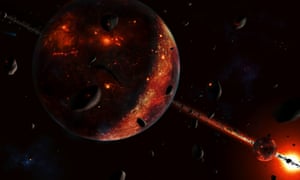The moon may have formed after an ancient rocky bombardment that pummelled the Earth and sent trillions of tonnes of debris into orbit, scientists say.
Computer simulations show that a flurry of impacts over 100m years could have kicked up enough material to form orbiting moonlets, which gradually merged to make the moon.
A pelting from 20 rocky bodies, some moon-sized themselves, and some as large as Mars, would have been sufficient to do the job, according to researchers at the Weizmann Institute of Science in Israel.
The proposal contradicts the widely-held view that the moon was born from a single whopping collision in which a Mars-sized object landed a glancing blow on the fledgling Earth and blasted 70 billion billion tonnes of rock into space.
While popular, the idea that the moon was created in a one-off collision raises questions of its own. If the colliding body had a different chemical makeup to Earth, then traces of it should be seen in moon rock. But so far, tests have failed to find any sign of foreign material in the moon.
One possibility is that the body that crashed into the ancient Earth was made of exactly the same stuff as our planet. But Raluca Rufu, an author on the latest study, said that seems unlikely: in contrast to the Earth and moon, meteorites and other material in the solar system vary substantially in their chemical signatures.
Rufu ran a series of computer simulations to see whether a prolonged pelting from objects in the early solar system could have dislodged enough material from Earth to build the moon. In the computer models, some impacts were head-on and flung huge amounts of Earth rock into space, while others struck at shallower angles and lent the Earth its spin.
“We see that multiple impacts will have a high probability of building a moon with similar composition to the Earth,” Rufu said. “With 20 impactors, it would take about 100m years to build the moon.” Details of the study are published in Nature Geoscience.
The simulations showed that high energy impacts often sent plumes of debris filled with Earth rock up into space, where they formed discs around the planet. The material in each disc then clumped together into a moonlet which slowly spiralled outwards to coalesce with other moonlets and form a single, larger moon. The moon is still receding from Earth today, its orbit increasing by 4cm a year.
Rufu’s proposal that the moon could be made from 20 impacts relies on all of the collisions forming moonlets that gradually coalesce into one larger body. In reality, the making of a moon is unlikely to be so straightforward. Her focus now is to model moonlet mergers to see how efficient the process might have been. “As a scientist you always have to ask ‘is it true or not?’ If you have too much confidence in your theory something is wrong,” she said.
Gareth Collins, a planetary scientist at Imperial College, London, said that building the moon from a flurry of impacts was an appealing way to explain why the moon seems to have the same chemical signature to Earth. “It’s quite difficult, in one go, to get a lot of the Earth into orbit to form the moon. It can be done, but it requires very specific conditions which are rare, and you end up spinning the whole system a lot,” he said. “What’s nice about building the moon in stages is that some of the impacts can get stuff off the Earth and into orbit, and another set can set the Earth spinning.”
But Collins is not convinced. Instead of the moon forming in stages, he thinks that whatever hit Earth all those millions of years ago may have had the same chemical makeup after all.
The best shot at an answer may come from the Chinese space programme. Later this year, the nation’s space agency aims to send the Chang’e 5 to the moon to collect and return the first moon rocks since the Apollo missions. “If we had more lunar samples, that would be very helpful,” Rufu said. “One giant impact should produce a more homogenous rock, but under our scenario, I’d expect the composition to vary between different regions.”
Quelle: theguardian

